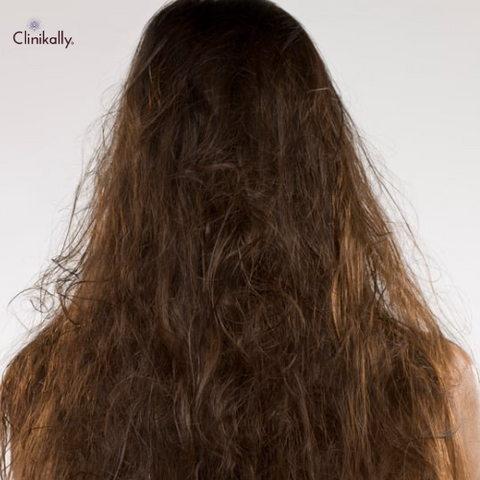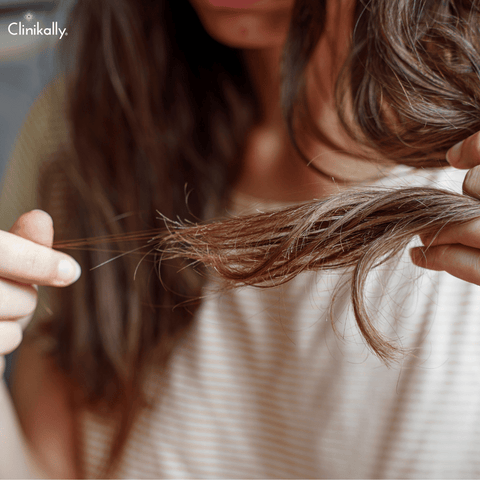Chelating agents like sodium EDTA (ethylene diamine tetraacetic acid) are frequently found in hair care products. Chelating substances attach to the metal ions in hard water, making it simpler to rinse them away. Disodium EDTA is useful in hair care because it dissolves build-up, increases product effectiveness, improves hair texture, lessens scalp irritation, and prolongs hair color. For those who live in locations with hard water or who use products that can lead to mineral build-up on the hair and scalp, disodium EDTA is a useful element in hair care products.
What is Disodium EDTA and How Does it Work on Hair?

Chelating agents like disodium EDTA (ethylene diamine tetraacetic acid) are frequently found in hair care products. It is a powder that dissolves in water and is made from amines and carboxylic acids. Chelating agents function by attaching to the calcium, magnesium, and iron ions that are frequently present in hard water. These metal ions can irritate the scalp and make the hair dry, dull, and brittle when they accumulate on the hair and scalp. Disodium EDTA aids in the removal of these metal ions from the hair and scalp, enhancing the effectiveness of hair care products and resulting in hair that feels and looks healthier.
Disodium EDTA can assist in eliminating additional pollutants from the hair, such as dirt, oils, and product build-up, in addition to metal ions. Since clarifying shampoos are meant to remove build-up and leave hair feeling clean and renewed, this makes it an effective component. Because it assists in removing impurities and enhances the effectiveness of other chemicals, disodium EDTA is a valuable element in hair care products. People who use products that can build up on their hair and scalp or live in places with hard water can benefit the most from it.
Disodium EDTA as a Chelating Agent for Hair Cleansing
In order to remove mineral build-up from the hair and scalp, disodium EDTA (ethylene diamine tetraacetic acid) is a chelating agent that is frequently included in hair care products. It functions by attaching to metal ions found in hard water and hair care products, such as calcium, magnesium, and iron, and making them simpler to rinse away. These metal ions can cause the hair to become dry, dull, and brittle when they accumulate on the hair and scalp. By assisting in their removal, disodium EDTA makes the hair and scalp feel cleaner and healthier.
Clarifying shampoos, which are made to remove build-up from the hair and scalp, frequently contain disodium EDTA. People who frequently use hair care products, have hard water, or swim in chlorine pools can benefit the most from these shampoos. Disodium EDTA can help other hair care products, such as conditioners and styling aids, operate better by eliminating build-up and mineral deposits from the hair and scalp. This is due to the possibility that mineral accumulation will prevent these products' absorption and effectiveness.
Disodium EDTA for Removing Mineral Deposits and Chemical Build-Up in Hair
The chelating agent disodium EDTA (ethylene diamine tetraacetic acid) is frequently used in hair care products to eliminate chemical build-up and mineral deposits from the hair. Chelating compounds function by attaching to metal ions, including calcium, magnesium, and iron, that are found in hard water, hair care products, and chemical residues from styling and treatment products. These mineral and chemical residues can accumulate over time on the scalp and hair, resulting in dull, dry, and brittle hair. These residues are removed with the aid of disodium EDTA, leaving the hair and scalp feeling clean and revitalized.
Clarifying shampoos, which are made to get rid of build-up and residue from the hair and scalp, frequently contain disodium EDTA. People who frequently use hair care products, have hard water, or swim in chlorine pools can benefit the most from these shampoos. Disodium EDTA can help other hair care products, such as conditioners and styling aids, operate better by eliminating build-up and chemical residues from the hair and scalp. This is due to the possibility that mineral and chemical build-up will prevent these products' absorption and effectiveness.
Disodium EDTA for Maintaining Hair Hydration and Health
Ethylene diamine tetraacetic acid, often known as disodium EDTA, is helpful for preserving the health and hydration of hair. It functions by removing chemical and mineral build-up and deposits from the hair, which can hinder the hair's ability to retain moisture. The build-up of chemical and mineral residues on the hair can form a barrier that stops moisture from entering the hair shaft. The result could be dry, lifeless, and brittle hair. Disodium EDTA helps to eliminate these deposits, restoring the hair's organic capacity to take in and hold moisture, leaving it to appear and feel moisturized and healthy.
To help with hair moisture and health, disodium EDTA is frequently included in hair care products like conditioners and deep conditioning treatments. People with dry or damaged hair, people who live in places with hard water, and those who frequently use hair care products can all benefit from it. To preserve the hydration and health of hair, disodium EDTA is a beneficial element in hair care products. The mineral and chemical residues that can damage and dry out hair are removed, leaving behind soft, silky, and healthy-looking hair.
How Disodium EDTA Benefits Different Hair Types?

Ethylene diamine tetraacetic acid, also known as disodium EDTA, has several advantages for various hair types.
-
Normal hair: Disodium EDTA can assist in clearing away chemical and mineral buildup from normal hair, giving it a clean, fresh look. It can also help to maintain hair hydration and health by removing the barrier that prevents moisture from penetrating the hair shaft.
-
Dry hair: Due to its ability to enhance hair hydration and replenish moisture, disodium EDTA is especially advantageous for those with dry hair. It aids in restoring the hair's natural capacity to absorb and retain moisture by getting rid of mineral build-up and chemical residues, leaving it looking and feeling moisturized.
-
Oily hair: Disodium EDTA can help clear the scalp and hair of excess oil and grime, leaving them feeling clean and revitalized. It can also help regulate oil production by removing build-up that can clog hair follicles and contribute to the overproduction of oil.
-
Colored or treated hair: Disodium EDTA can help remove mineral deposits and chemical residues from colored or treated hair, which can cause color fading and damage. Removing these deposits protects hair color and maintains hair health.
-
Chemically treated hair: Disodium EDTA can help remove chemical residues left by hair treatments like perms or relaxers. Removing these residues helps restore the hair's natural pH balance and prevent damage.
For many hair types, disodium EDTA is a valuable element in hair care products. It assists in maintaining hair hydration and health, controlling oil production, safeguarding hair color, and restoring the pH balance of the hair. It also aids in removing mineral deposits and chemical build-up.
Disodium EDTA for Oily and Greasy Hair: Detoxifying Sebum Build-Up
People with oily or greasy hair may benefit from disodium EDTA (ethylene diamine tetraacetic acid) since it aids in detoxifying sebum build-up on the scalp and hair. The sebaceous glands on the scalp create sebum, an oily material. Although excessive sebum production can result in oily and greasy hair as well as the accumulation of dirt, product residues, and pollutants on the scalp, sebum is necessary for healthy hair and scalp.
As a chelating agent, disodium EDTA can bind to and eliminate the mineral and chemical residues that cause sebum build-up on the scalp and hair. By removing these remnants, the hair and scalp are detoxified, leaving them feeling clean and revitalized. Disodium EDTA is frequently used in deep cleansing treatments for thick and greasy hair as well as clarifying shampoos. These goods aid in controlling oil production, preventing sebum build-up, and removing excess oil and dirt from the hair and scalp. For oily and greasy hair, disodium EDTA is a helpful element in hair care treatments. It aids in detoxifying excess sebum, controlling oil production, and preserving the health of the scalp and hair.
Disodium EDTA for Dry and Brittle Hair: Nourishing and Hydrating Hair Follicles
Sodium EDTA (ethylene diamine tetraacetic acid) can help people with dry and brittle hair by feeding and moisturizing hair follicles. Numerous things, including environmental stresses, excessive use of heat styling products, and a lack of moisture, can lead to dry and brittle hair. As a chelating agent, disodium EDTA can bind to and eliminate mineral and chemical residues that could harm and dry out the hair. Disodium EDTA helps the hair regain its natural capacity to take in and hold moisture by getting rid of these residues, giving it a hydrated and healthy appearance and feel. It may also support healthy hair development by nourishing hair follicles. Disodium EDTA is commonly found in deep conditioning treatments and leave-in conditioners for dry and brittle hair. These products nourish and hydrate the hair while also restoring its natural moisture balance and improving its overall health and appearance.
Disodium EDTA for Colored and Treated Hair: Minimizing Chemical Damage and Enhancing Hair Texture
People with colored and treated hair can benefit from disodium EDTA (ethylene diamine tetraacetic acid) by reducing chemical damage and improving hair texture. Chemical procedures like coloring, perming, and relaxing the hair can alter the pH balance and natural structure of the hair. The mineral and chemical residues left on the hair as a result of these treatments can be bound to and removed using the chelating agent disodium EDTA. These residues are removed by disodium EDTA, which also balances pH and reduces the harm caused by chemical treatments. By boosting and improving its elasticity, it can also aid in enhancing the texture of the hair. The color-protecting component disodium EDTA is typically found in shampoos and conditioners for colored and treated hair. These products keep the color vibrant and prevent fading while improving the hair's overall health and texture.
How to Use Disodium EDTA for Hair Care?

Disodium EDTA (ethylene diamine tetraacetic acid) is a common ingredient in hair care products like shampoos, conditioners, and treatments. Here are some ideas for incorporating disodium EDTA into your hair care routine:
-
Use disodium EDTA products as directed: Look for disodium EDTA-containing hair care products, such as clarifying shampoos or deep conditioning treatments, and follow the directions on the product label. These products are intended to be used in specific ways, such as leaving them on the hair for a specific amount of time or only once a week.
-
Overuse: While disodium EDTA can be beneficial for hair care, excessive use can cause dryness and damage. Use disodium EDTA-containing hair care products sparingly and only as directed.
-
Combine with other hair care components: Disodium EDTA is effective when combined with other components for hair care, such as protein treatments or hydrating oils. Look for products that have a blend of ingredients that are specially formulated for the needs and type of your hair.
-
Rinse well: After using disodium EDTA-containing hair care products, make sure to rinse well to get rid of any remaining product residue. This will aid in avoiding hair damage and dryness.
Disodium EDTA, in general, is a helpful component in hair care products that can benefit various hair types. However, it's crucial to use it sparingly and according to instructions to prevent any potential harm or drying out of the hair.
Incorporating Disodium EDTA into Your Hair Care Routine: Dos and Don'ts
Ethylene diamine tetraacetic acid, often known as disodium EDTA, is a helpful element in hair care products that can improve many hair types. Following are some suggestions for using disodium EDTA in your hair care regimen:
Dos:
-
Follow the directions on any hair care products that contain disodium EDTA. Only utilize the product in accordance with the manufacturer's instructions and the label.
-
Disodium EDTA should be used sparingly. Overuse of disodium EDTA can cause hair dryness and damage.
-
Disodium EDTA can be combined with other hair care ingredients that enhance its benefits, such as hydrating oils or protein treatments.
-
After using disodium EDTA hair care products, thoroughly rinse your hair to get rid of any leftover product.
Don'ts:
-
Never use disodium EDTA by itself. When combined with other hair care ingredients that enhance its advantages, disodium EDTA is the most effective.
-
Avoid overusing disodium EDTA-containing hair care products. The hair may become dry and brittle from overuse.
-
Avoid leaving disodium EDTA-containing hair care products on the hair for too long. Use the product only in accordance with the instructions on the label, provided by the manufacturer.
-
If you have a sensitive scalp or an allergy to any of the ingredients, avoid using disodium EDTA. Make sure to look for any cautions or warnings on the product label.
Different hair types can benefit from the use of disodium EDTA as an ingredient in hair care products. It can assist in clearing away mineral and chemical build-up, re-establishing the pH balance of the hair, and encouraging the growth of healthy hair when used as instructed and in moderation.
Disodium EDTA as an Ingredient in Hair Products: Choosing the Right Hair Products
Ethylene diamine tetraacetic acid, often known as disodium EDTA, is a typical component in shampoos, conditioners, and hair treatments. Here are some suggestions for picking the best hair products with disodium EDTA:
-
Think about your hair type: Different hair care products are needed for various hair types. In order to help detoxify sebum build-up, look for products with disodium EDTA if you have oily hair. Look for products with disodium EDTA that can hydrate and nourish your hair if it is dry or brittle.
-
Look for products with the appropriate disodium EDTA concentration: The concentration of disodium EDTA in hair care products can vary. Look for products with a disodium EDTA concentration that is appropriate for your hair type and needs.
-
Examine the label: Examine the label of any hair care product to see if it contains disodium EDTA. Look for other ingredients, such as hydrating oils or protein treatments, that can supplement the benefits of disodium EDTA.
-
Select high-quality products: Look for high-quality hair care products that contain natural ingredients. Avoid products containing harsh chemicals that can cause hair dryness or damage.
-
Consult a hair care professional: If you're not sure which hair care products to use, talk to a professional. They can suggest products that are suitable for your hair type and needs.
Different hair types can benefit from the use of disodium EDTA as a component in hair care products. You may encourage healthy hair growth and preserve the general health and appearance of your hair by selecting hair products that contain disodium EDTA and other beneficial chemicals.
Potential Side Effects and Safety Precautions of Disodium EDTA

When used in accordance with instructions, disodium EDTA (ethylene diamine tetraacetic acid) is regarded as safe for use in hair care products. There are a few possible negative effects and safety measures to be aware of, though:
-
Skin irritation: In some people, disodium EDTA can cause skin irritation. If you experience redness, itching, or swelling after using a disodium EDTA-containing hair care product, stop using it immediately and consult a healthcare professional.
-
Eye irritation: Disodium EDTA can cause eye irritation as well. If you get disodium EDTA in your eyes, flush them with water and seek medical attention if necessary.
-
Allergic reactions: Some people are allergic to disodium EDTA or other ingredients in disodium EDTA-containing hair care products. Before using the product, read the label carefully and perform a patch test.
-
Interference with nutrient absorption: Disodium EDTA can chelate (bind to) minerals in the body, which can interfere with nutrient absorption. However, the amount of disodium EDTA in hair care products is usually insufficient to produce this effect.
-
Environmental concerns: Disodium EDTA is not biodegradable and can contribute to environmental pollution if not properly disposed of.
Follow the directions on the product label, use the product sparingly, and dispose of the product appropriately to reduce any potential dangers connected with disodium EDTA. Consult a healthcare provider if you have any questions regarding the safety of disodium EDTA or other substances in hair care products.
Final Thoughts: Is Disodium EDTA Worth Using in Your Hair Care?

A helpful element in hair care products, disodium EDTA can assist different hair types in a variety of ways. Mineral buildup and chemical buildup can be removed, hair health and hydration can be preserved, and damage to colored and treated hair can be reduced. However, there are possible side effects and safety considerations to keep in mind with every ingredient. Disodium EDTA may or may not be beneficial for your hair care regimen, which ultimately depends on your personal requirements and preferences. Disodium EDTA can be a wonderful option if you're seeking a hair care product that will assist in detoxifying your hair and enhancing its general health. However, you might want to think about alternate hair care solutions if you are worried about possible negative effects or would rather use all-natural products. It's crucial to carefully read the label, abide by the directions, and get medical advice if you have any questions when selecting hair care products that contain disodium EDTA. You can aid in promoting healthy hair development and maintaining the general health and appearance of your hair by using disodium EDTA and other complementing components sparingly and in accordance with directions.
















